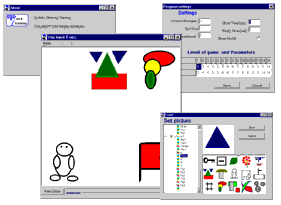

I usually find it much, much easier to look at the pictures than to try to remember the file names. When I store pictures on my computer hard drive, I can look for them in two ways: I can look through a list of their file names, or I can look through a folder with thumbnails of the images. I think it’s a good thing when researchers try to explore multiple possible explanations for results.īut I am puzzled as to why the researchers don’t even mention the obvious: maybe dyslexics just store memories of images in their minds better than non-dyslexics. Researcher suggestion #3: Maybe the declarative memory (conscious memory for facts and experiences) is improved in dyslexia as a way to compensate for deficits in procedural memory (subconscious memory based on repetition and practice) is impaired. Researcher suggestion #2: Maybe the dyslexic children were simply normal in their ability to remember pictures, but the non-dyslexic group was impaired because the process of learning to read required them to use up space in their brains to remember sight words, thus reducing the available memory available for remembering other stuff they saw. Researcher suggestion #1: Maybe dyslexic children are better at making up new labels in their brains for things they see, to compensate for their “lexical retrieval deficits.” Then when they see the objects again, they have their new labels available to jar their memory. That led them to propose three different, rather convoluted, reasons for the disparity in ability: So they were puzzled when it turned out that the dyslexic children were so much better at remembering the pictures. So they expected that once they eliminated word-memory from the experimental setting, dyslexics would perform about the same as other children. In other words, they wanted to test memory in dyslexic children without needing to rely on the ability to remember or recall words.
FREE EIDETIC MEMORY TEST FREE
Based on previous evidence indicating that declarative memory impairments in DD may be related to less efficient encoding strategies and/or problems with free recall, we predicted that the present paradigm would yield intact performance in the DD group. The aim of the present study was to investigate a previously untested aspect of declarative memory in children with DD, namely recognition memory after incidental encoding. I suppose they used pictures in their memory test simply because they could not expect children with known reading difficulties to remember words. Why? Because they thought they were studying declarative memory (memory of factual knowledge and personally experienced events), not picture-thinking. They had hypothesized that both groups of children would perform about the same. imaginary objects, and much better at remembering whether they have seen a picture before.īut apparently that was not the result the researchers expected to see. Dyslexic children are marginally faster at distinguishing whether drawings depict real vs. As I would anticipate, the dyslexic children performed significantly better on those tests of visual memory. The researchers compared the performance of group of 11-year-old dyslexic children with a group non-dyslexic children on tests of how well they remembered line drawings 10 minutes and 24 hours after first being shown the pictures.

I was even happier, when I read the study, to see that the results were exactly as I had anticipated. Simple intensity levels allow you to select the length of the testing period.So I was delighted to see the recent publication of a study with the title Enhanced Recognition Memory … in Children with Developmental Dyslexia. Cool, I thought – researchers who are focused on studying a dyslexic gift. By spacing the tests out over time it helps you to retain the information in long-term memory, this is known as the 'spacing effect'.īuilt in flashcard types make it easy to add items: Perfect for students looking to remember those key facts or anyone who wants to remember friends phone numbers, new bank details or just cool words, quotes or facts you come across!Įidetic uses notifications to remind you when it's time to test yourself. It works differently from typical brain training apps by using items that have meaning and context. Eidetic uses a technique called spaced repetition to help you memorise anything from important phone numbers to interesting words or facts.


 0 kommentar(er)
0 kommentar(er)
